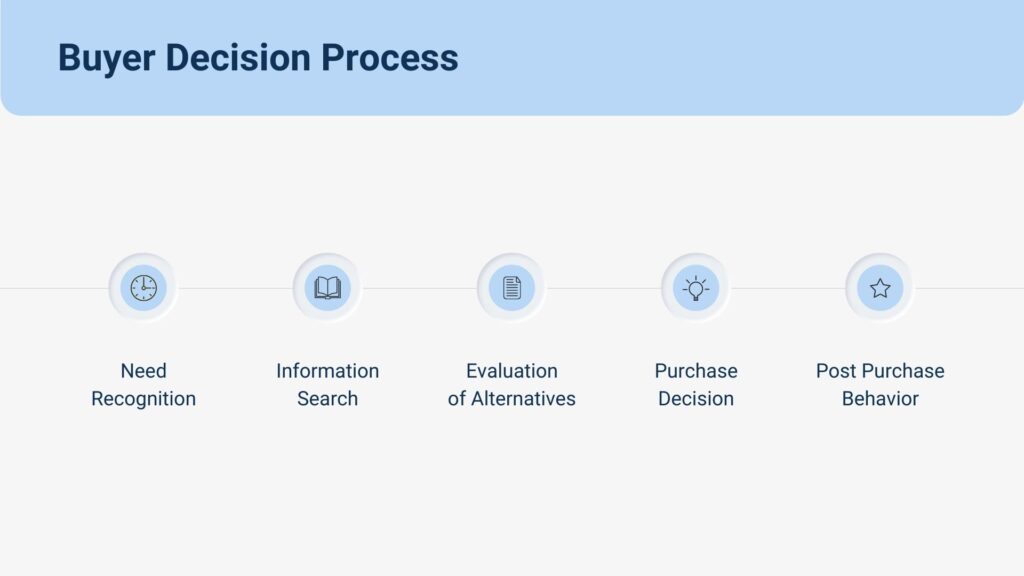Importance of understanding the consumer decision making process
Understanding the consumer decision-making process is important for marketers because it helps them understand what motivates consumers to buy a product or service. When a marketer begins developing a marketing strategy, they need to consider how their target audience will decide which products and services are best for them. The most effective marketing strategies often include understanding how customers make decisions about what they want to purchase.
For example, if your company wants to sell flowers, you might start by studying your potential customer’s purchasing habits before coming up with an idea of what type of flowers they like. Understanding their preferences can help you determine where your company should focus its efforts on selling the flowers that would be most profitable for you.
What are the 5 stages of the consumer decision making process?
The five stages of the decision process are i)Need recognition, ii)Information search, iii)Evaluation of alternatives, iv)Purchase decision, and v)Post-purchase behavior.

Need Recognition
The need recognition stage is the first step in the decision making process. This phase of the decision making process starts with individuals trying to identify their needs and then searching for information that will help them satisfy those needs. At this point, consumers are not yet aware of what they want or don’t want, but they are very interested in knowing more about what they might need. At this point of problem recognition, consumers are also not sure if their needs are already met by existing brands or other products available on the market.
In this stage, consumers evaluate their personal values and desires to identify a need. The products that are offered will influence what they want from their purchase. If they see a product that aligns with their values, then they will have a higher chance of buying it. If there is no alignment between the consumer’s personal values and desires, then they will look for another option that does have an alignment between them so they can fulfill their needs more effectively.
Information Search
The information-gathering phase involves the individual gathering information about a product, evaluating it, and deciding whether or not to purchase it. Information-gathering is made up of three main steps: searching for relevant product information, gathering opinions from other people on what they think about the product, and researching more general topics related to the item being purchased.
Some of the sources for information search:
- Television and Radio: There are many types of television and radio channels that provide information about different products, services, and companies.
- News: News provides important updates on what is happening in the world today as well as reporting on consumer news such as trends, fads, events, disasters, etc.
- Social Media: Internet social media platforms like Facebook and Twitter can be used to find out about trending topics or ask for opinions from friends and family members on various products or services that you may be considering purchasing or using for your business.
- Advertisement: Advertisements are everywhere in the media. Adverts can be found on many different mediums, but frequently commercials will show up in your television shows and movies.
- Word of mouth: Information is also gathered from what people say and do in their own personal lives. This is arguably the most effective way for someone to find out about a product without having to pay money for any type of advertising, but it can be very threatening to companies that sell such products.
Evaluation of Alternatives
The evaluation of alternatives stage is when consumers have a number of options to choose from and they are weighing the costs and benefits. This is typically the most important stage in the decision making process because it’s where people make their final decisions about what they want to buy. A consumer may begin by researching what products are available in a particular category, such as cars, laptops, mattresses, etc. They will then choose a particular product from their research and compare it with other options that may be available in that category.
During the purchase evaluation stage, consumers use different criteria to evaluate each alternative before choosing which one will be best for them. Some of these criteria might include:
- Price: Consumers will compare products and services that have the same features but with different prices, such as a $500 laptop versus a $1000 laptop or two laptops priced at $100.
- Reliability: Consumers may also compare products and services with differing reliability like a Windows computer versus an Apple Mac OS X computer or two computers of different brands, such as Dell and Hewlett Packard (HP). They might be willing to pay more for a premium brand because they have a good reputation for being more reliable.
- Warranty: Consumers may also compare products based on their warranty value as well as the service level that will be offered with each product.
They might choose based on price, features, warranties, or even brand reputation. This stage ends when consumers have found an option that they feel best fits their needs and meets their criteria for purchase.
Purchase Decision
This stage starts with the consideration of whether or not to purchase a product and ends when they have decided to purchase the best option. Buying decision begins when a consumer has gathered enough information about a product or service to make a purchasing decision. Both internal stimuli and external stimuli from the previous stages of the buying decision processes will influence the consumer journey through the decision-making funnel. The purchase decision typically occurs in-store or online at that point in time after having completed some form of price comparison research (e.g., researching prices on Amazon).
During this stage, consumers may be undecided about which product or service they want to buy, but are already leaning towards one option over another because they have done preliminary research into its price and quality attributes (e.g., researching reviews on Amazon). This can be an effective marketing strategy for any business as it helps them understand what customers are looking for and how they might want to improve their products or services so that they become more appealing to customers.
Post-purchase behavior
After the purchase decision is made, consumers move on to post-purchase evaluation. This is where they follow through with their purchase by using the product or service and testing it out. It refers to a set of behaviors that consumers engage in after they have made a purchase, whether it is buying something online or offline. Some examples of post-purchase behaviors are:
- Checking out their receipt and reviewing what they just bought to see if it was worth the money spent.
- Searching for ways to use what they just purchased as opposed to just storing it away.
- Going back online or offline to buy more products from that company.
Post-purchase dissonance happens when a customer feels that they have been misled or fooled into buying something that was not what they were expecting. A purchase decision process can be good if it includes a clear message and a proper website where customers can read about products and services offered by your company before making the purchase.
As a marketer, one of the most important steps to take is ensuring that your customer’s post-purchase experience is as smooth and enjoyable as possible. To do this, it is important to create a positive relationship with your customers so they will feel comfortable making a purchase from you again in the future. Here are some tips on how to reduce post-purchase dissonance:
- Take time to thank them for their business after the sale. Make sure you provide them with all of the information that they need to know about their order including shipping details and contact information.
- Give your customers an incentive or discount code if they’ve made multiple purchases from you in the past few months or even years. This will make them feel like valued members of your community who are deserving of special treatment!
- Send out personalized emails with different content for each individual customer, depending on what type of product they purchased and what problems it solved for them (e.g., “Hey Lisa! I’m excited that you’re now able to enjoy our new t-shirt collection!”). This creates an exclusive feeling within your email marketing campaign that will keep customers coming back for more.
- Another way is to provide a clear return policy or guarantees on your products so that customers know what they are getting into before they buy them.
- Finally, you should have customer support representatives who are knowledgeable about the product and can answer any questions that customers may have about it.
